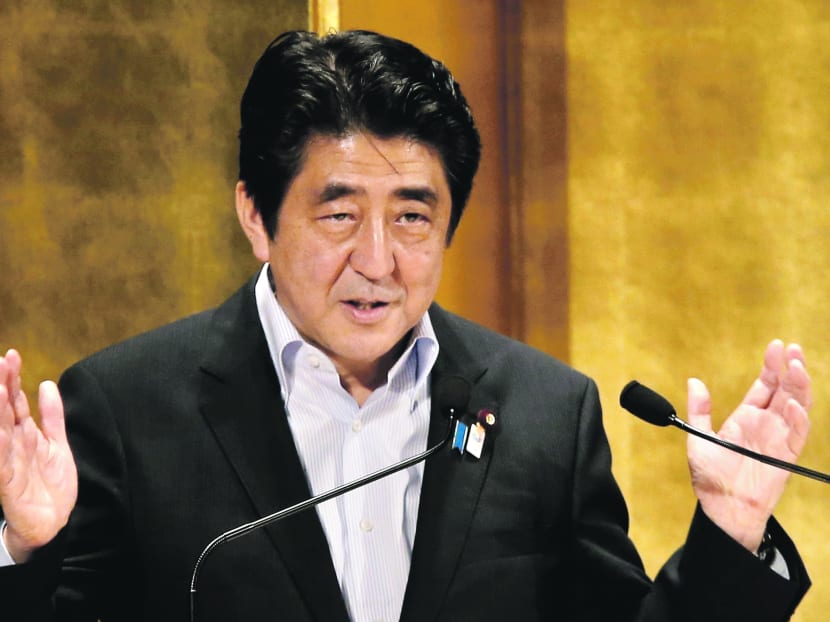Abe’s ‘third arrow’ fails to impress
TOKYO — Prime Minister Shinzo Abe has outlined a sweeping blueprint for kickstarting Japan’s ailing economy, with reforms meant to promote industrial innovation and investment, but as far as the markets were concerned his much-anticipated “third arrow” missed the target.

The initiatives outlined by Mr Abe yesterday included setting up special economic zones to attract foreign businesses. Photo: Reuters
TOKYO — Prime Minister Shinzo Abe has outlined a sweeping blueprint for kickstarting Japan’s ailing economy, with reforms meant to promote industrial innovation and investment, but as far as the markets were concerned his much-anticipated “third arrow” missed the target.
The strategies he sketched out in yesterday’s speech form the third plank in his “Abenomics” platform, which so far has focused on what he called the first two “arrows” in his arsenal: Loosening monetary policy and boosting public spending. He has promised structural reforms to underpin growth in the long run as Japan’s population ages and shrinks.
Government officials said the plans, if implemented, would end Japan’s decade of deflation, and lead to expansion averaging 2 per cent a year in real terms over the next decade, more than double the pace of the past 10 years.
“Now is the time for Japan to be an engine for world economic recovery,” Mr Abe said. “Japanese business, what is being asked is that you speed up. Do not fear risk, be determined and use your capacity for action.”
But investors were unimpressed by a speech that was long on ambition and short on detail. After a rise of more than 80 per cent since mid-November, when Mr Abe began his election campaign, the stock market has pulled back with a vengeance. The Nikkei Stock Average plunged 3.8 per cent to 13,014.87 points yesterday and has now fallen about 20 per cent from its peak in mid-May.
The fall put pressure on other markets across the region, with Singapore’s Straits Times Index (STI) falling 1.46 per cent to its lowest closing since March 4. Korea’s benchmark index lost 1.5 per cent and Hong Kong’s Hang Seng dropped 1 per cent.
“We’re going to have to reduce our expectations for Abenomics,” said Ms Ayako Sera, a strategist at Sumitomo Mitsui Trust Bank. “The initiatives are too small. The direction is right but the comments are all long-term. It looks like things are going to move too slowly.”
Mr Abe promised a grab bag of measures, ranging from reforms to the stagnant agriculture sector, to new tax breaks encouraging foreign investment and venture capital as part of an attempt to raise incomes by 3 per cent annually. In a move specifically aimed at the markets, Mr Abe’s plan includes a proposal to loosen investment rules for Japan’s mammoth public pension funds, allowing them to buy more stocks and shed some of their stable, but low-return, government bonds.
Rising incomes are vital to the success of the ambitious goals to end entrenched deflation and decades of economic stagnation.
“The aim of our growth strategy is nothing other than to create jobs for enthusiastic people and raise take-home pay for those who are working hard,” Mr Abe said. “In short, to let households benefit. That’s the point.”
The Prime Minister also said the government would allow the sale over the Internet of most over-the-counter drugs as part of efforts to mobilise the Internet for growth.
Mr Abe added more targets to those he has already announced, aiming to boost power-related investment one-and-a-half times to ¥30 trillion (S$376 billion) over the next decade and double the balance of inward foreign direct investment to ¥35 trillion by 2020.
To help achieve those targets, special economic zones will be created in Tokyo and other big cities. They are expected to be allowed to introduce corporate tax cuts and ease regulations to attract businesses.
But analysts were sceptical about whether the economic vision is achievable.
“The government has come up with rosy numerical targets but I doubt any of these could be met or that such a targeting policy could work out as planned,” said Mr Hideo Kumano, chief economist at Dai-ichi Life Research Institute.
“After all, the government cannot control every economic activity just like the central bank cannot control long-term interest rates.”
However, others said there is scope for additional reforms if necessary.
“The growth strategy is going in the right direction, but it lacks bold steps such as facilitating labour mobility, immigration and corporate tax cuts,” said Mr Masayuki Kichikawa, chief Japan economist at Bank of America Merrill Lynch. AGENCIES





